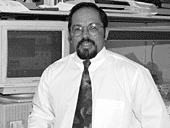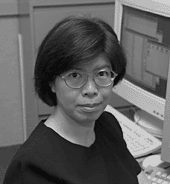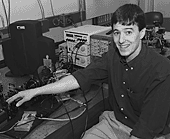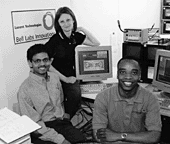|
|
|
|
|
Profiles of Scientists
|
Profiles of ScientistsEvery day at Lucent Technologies, scientists are researching, inventing, and developing innovative technologies that are changing our world. Through their passion, excitement, curiosity and persistence, they pave the way for a future generation of scientists. 
Philip J. Muñiz
Philip Muñiz works in the RF (radio frequency) /High Speed Design and Manufacturing group helping to design technologies that will improve communications access around the world. I wake up excited to go to work every day—I love my job and I love interacting and working with other people. To me, good scientists or engineers are people who have a deep curiosity about the world around them, and an interest in improving the world and how we interact with that world. I believe wireless communication can provide such benefits as a quicker response worldwide to tragedies like earthquakes. While I’ve always been curious about how things work, I didn’t always know what I wanted to do. Life is a series of figuring out what you don’t like to do. Right out of high school, I spent four years in the army, worked as a carpenter’s apprentice, and worked in an office delivering mail and running errands. When the company I was working with at the time offered me training in computers, I took it. That’s where I learned I had an interest in computers. Ten years out of high school, I decided to go back to school full-time to earn a degree in computer science with an electrical engineering minor, and later I earned my graduate degree in Engineering Science while working full-time. That wasn’t easy, but I did it! You should remember that the door doesn’t always open all the way. You need to be flexible and willing to look at opportunities in lots of different ways. My opportunity to work as a permanent employee at Lucent didn’t come for 3 years. I proved myself as a contractor and subsequently, they hired me. I’ve worked at Bell Labs for 12 years now, and I get paid to play!  Chilin Shih
Chilin Shih works on the multilingual text-to-speech systems. These systems translate the complexities of written language into speech. Some of the languages Shih has worked on include Mandarin, Spanish, Italian, Japanese, Romanian, Russian, Navajo, Greek, and Hindi. To experience for yourself how Text To Speech technology works, visit AT&T Labs-Research at http://www.research.att.com/projects/tts/. I really like that I’m working on something that is not abstract, that actually talks and that people are using and enjoying. The text-to-speech systems can help teach languages, read to the blind, be the voice for those who have lost theirs, and operate as a messaging system. It has a direct link to this society and gives back to it. In order to make text-to-speech actually recreate speech, you must understand the properties of speech from every perspective: physics, psychology, linguistics, math and statistics, engineering, computer science, and algorithms. You collaborate with experts in all different fields, and, over the years, you become a semi-expert in everything. I am constantly learning. It is important that you have a broad-based training because you never know what you are going to do in your life. I wanted to write novels, majored in literature in college, and got a graduate degree in linguistics. There is no education that is useless. Every background I have gives me a unique perspective in looking at the problem I am trying to solve. Never let what you don’t have put you down. You can always look at things positively and negatively. Think of what you have and build on it. What you don’t have doesn’t matter because you can still learn it now. Every day is a learning opportunity.  John Rogers
John Rogers researches and develops new microfabrication and patterning techniques. The rubber stamp he’s helped develop can imprint features on a variety of surfaces and materials that cannot be processed with conventional methods. This breakthrough innovation may lead to novel applications in the communications realm and plastic transistors with features as small as those in their silicon counterparts. I love discovering how something works, how to make it work better, and how to make things that are new and people haven’t thought of before. I work with a variety of materials, many of them so small that you can’t see them through even the most powerful optical microscopes. The systems, objects, and apparatus that I work with in the lab are all interesting at a very basic level, and they can grab the attention even of non-scientists — high power, multi-colored pulsed lasers, fine strands of glass wrapped tightly with microscopic silver and gold microcoils, rubber diffraction gratings, and glowing polymer films. I am also fortunate to work with people who are experts in just about any field of science or technology you could imagine. Science is incremental and collaborative—everybody’s work relies on others’ past work. Bell Labs provides a great environment for collaboration and flexibility. There are a million things to do here. I feel like I always knew that I wanted to be a scientist. My dad has a Ph.D. in physics and my mom is a poet who writes about nature and science, so I was exposed early on to thinking about the aesthetic side of science as well as to a more rigorous approach to what happens around us. In my work, I’m surrounded by visually stunning and beautiful objects, while learning to understand them, how to make them, and how to manipulate them. It’s the beauty of science that draws you in and the depth of understanding that keeps you there.  Yves Darly Jean, Gopal Pingali, Agata Opalach
Yves Darly Jean: Specializes in 3D computer graphics rendering and visualization. Gopal Pingali: Specializes in image and video analysis, integrated audio-visual processing and multimedia computing. Agata Opalach: Specializes in the extraction, visualization, and quantitative analysis of three-dimensional data. This team of scientists created LucentVisionTM, the first real-time visual information system for sports broadcast. The system uses computer vision techniques to track the position, direction, and speed of movement of players and the ball. Multiple cameras attached to a computer are used to determine player and ball motion. The information stored by the computer is analyzed and presented to viewers as virtual reality replays and color-coded charts using 3D computer graphics and animation techniques.You can see how they chart the tennis game at http://www.atptour.com. One of the most exciting things about this project is being able to apply our research to a live event in the real world and then broadcast that back for an audience to understand aspects of the game in an easier, quicker, and more compact way. People, from coaches to broadcasters, are using this technology to help analyze players’ game strategies. An interesting aspect of this project has been meeting another world – the sports world. It’s exciting that we have to learn about their world—how they work, their lingo, etc.— and they have to learn about ours. A big part of science is explaining what you have so that others can understand its potential value and build upon it. We had to sell this idea to the Lucent corporate people as well as to the ATP tennis group. We probably wouldn’t be doing this now if we weren’t good at communicating our ideas. Only a team of people could pull off something as big and complex as what we are doing. Each member has his or her own specialty and his or her own contribution, yet we all learn from one another. The fact that we have different personalities and different backgrounds makes it a more enjoyable and rich situation. But, what bonds us together is working toward a common goal and producing something that is very interesting. When you work with people who are extremely competent and whom you trust and who share your vision, it seems like you can do almost anything! For information about career opportunities at Lucent Technologies, visit http://www.lucent.com. For more information about Bell Labs innovations visit http://www.bell-labs.com
To order the video call PBS Learning Media at 1-800-344-3337.
Copyright 1999, ScienCentral, Inc, and The American Institute of Physics. No portion of this web site may be reproduced without written permission. All Rights Reserved. |
||||||||||||||||||||||||||||||||||